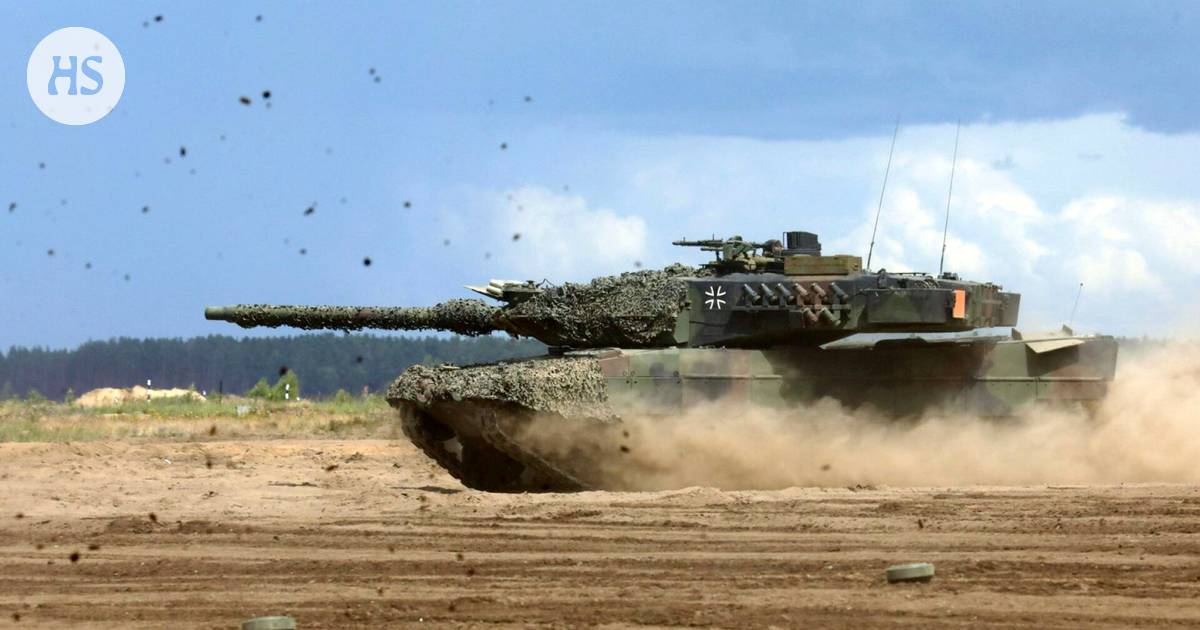The pressure on NATO countries to increase their defense budgets is strong, but a new promise was made in Vilnius. The researcher reminds that discussions on debt at the EU level can also affect defense investments.
Unsuccessful counsel. No significant effect.
Among other things, this is how NATO experts describe the recording of the level of defense appropriations, which the allied countries committed to at the Vilnius summit earlier in July.
The countries promised to spend annually and permanently on their defense spending at least two percent in relation to its gross domestic product.
Two percent will therefore be the floor in the future, not the ceiling, as NATO’s general secretary said Jens Stoltenberg has repeatedly described the new alignment. NATO is characterized, that the defense allocation promise in question is more ambitious than before.
However, the change is quite minor, and it reflects differences of opinion on the matter, experts estimate.
“About me they’ve basically just reformulated the language of 2014 and tried to give the best possible picture of what I think was really a failed negotiation within the alliance on whether and how to raise the minimum level,” says a US security policy expert John R. Deni.
He is a research professor of security studies at the United States Army War College’s Institute for Strategic Studies.
Deni points out that there was no “ceiling” in the previous defense budget commitment. It was also clearly intended as a minimum level. So in Vilnius, there was no change in this regard.
NATO the previous defense appropriation promise is from 2014.
At the Welsh Summit aligned at that time, summarizing that the countries that already spend the minimum amount of NATO’s goal, i.e. two percent, for their defense, strive to continue to do so. And the countries that do not rise to this level seek guidance towards movement. Time was given for ten years, i.e. until next year.
Also a senior researcher at the US CSIS research institute, British Sean Monaghan says that Vilna’s new registration “wasn’t so new”.
At the same time, he thinks it’s good that a consensus was found on defense spending in general, considering that there are big differences in the views of the countries.
Before Vilnius, some countries aimed to increase the percentage from two.
For example, Poland and the Baltic countries already spend three to four percent on their defense. At the same time, some countries are still well below two percent, and economic pressures make it difficult to justify defense investments.
The freshest NATO forecast According to
At the same time, investments have grown considerably. In 2014, only three member countries reached the figure of two percent.
This year, defense appropriations are predicted to grow by more than eight percent in Europe and Canada.
Another NATO goal is that 20 percent of the defense budget should be used for equipment purchases. In the light of recent figures, all member countries reach this.
Monaghan believes that the countries will continue to increase their defense investments and that more countries than now will reach the goal by next year’s Washington summit. However, this is mainly due to the weakened security situation, not the promises made in Vilnius.
Research professor Deni also says that he is not convinced that the records made in Vilnius would have any effect. In theory, similar goals can put pressure on governments. However, countries have responded better to security threats, such as Russia’s invasion of Ukraine.
Leaders of NATO countries at the summit in Vilnius in July.
NATO the defense allocation debate is not only economic but also very political, as it gives one picture of how the burden is shared in the federation.
His own discussion is that the meter does not tell everything at all. In Finland, for example, it is common to point out that it does not show that Finland’s conscription-based system is cost-effective compared to the salary armies of many countries.
Right now, defense budgets are being watched closely anyway, because NATO is doing its own defense a big turn towards Cold War settings as a result of Russia’s aggressive development.
In Vilnius, the allies approved new regional defense plans, the most comprehensive since the Cold War. The countries are trying to get up to 300,000 soldiers ready for rapid action instead of the previous 40,000. In addition, among other things, NATO is renewing its command structure.
Money is needed for all this, because in recent decades the allied countries have had time to reduce their armed forces and focus on smaller operations abroad.
Cold in times of war, the average level of NATO countries’ defense budgets, even without the United States, used to be more than three percent in relation to gross domestic product.
Now the question is whether even two percent investments in the ambitious plans NATO has for refurbishing its defenses are enough.
Research professor Deni believes that even reaching all countries would not be enough. The matter will become more clear when the work progresses in NATO.
“Would it be 5 to 10 percent? I don’t think so much. But probably [tarvittaisiin] more than two percent, in order to reach all the capacity goals that the federation must achieve,” says Deni.
In the declaration of the Vilnius meeting, it was already recognized that in many cases investments of more than two percent are needed in order to fix the existing deficiencies.
Researcher Monaghan points to how after the Cold War the balance changed and more public money was invested in civilian spending relative to defense spending.
“Now this has to change and it has to change faster. Change is happening, but maybe not fast enough.”
Researchers believe that the discussion on defense investments will continue before the summit organized in Washington next year.
The development may be partly influenced by how the war in Ukraine progresses. In any case, Russia is increasingly aggressive and very capable, says Monaghan.
However, the environment in which defense spending should be increased is not easy.
Inflation is raging with high energy prices. At the same time, for example, long-term challenges such as climate change should be answered.
Monaghan also reminds us that at the same time NATO is discussing increasing defense budgets, the European Union is discussing how much debt countries should be allowed to take on. It is a matter of weighing related to the so-called Stability and Growth Pact.
If there is pressure to cut public spending, this can also affect the possibilities of making defense investments.
French President Emmanuel Macron and German Chancellor Olaf Scholz at the NATO summit in Vilnius in July.
The freshest in the light of the figures, Germany, France, Spain and Italy, i.e. the large European countries of NATO, still fall short of the two percent goal.
Finland clearly exceeds the limit – largely due to large purchases, such as fighter jet purchases and Navy ship purchases. In the light of the new calculations, the decisions already made would increase to two percent until 2027, Minister of Defense Antti Häkkänen (kok) said recently In an interview with HS. The government has stated that it will keep the two percent level. Häkkänen did not set out to pursue more.
Germany in particular has long been an eyesore in NATO because of its low defense allocations, 1.57 percent this year.
It has now told about the “Zeitenwende”, i.e. the change of era and additional investments in its armed forces. To the recently published security strategy it is recorded that defense spending will be raised to the level of two percent. Chancellor Olaf Scholtz
Has said
this will happen next year.
Last year, a special fund of 100 billion euros was created to reform the armed forces. It is scheduled to increase defense appropriations for some years. According to the experts, the question is what happens after this.
In Germany’s new strategy, the formulation is that two percent of GDP will be invested in defense over an average period of several years.
Council is a European researcher at the Foreign Relations think tank, specializing in Germany Liana Fix points out that the strategy does not define what a period of many years means.
He says that Germany’s promise leaves room for maneuver, which reflects the fact that Germany has not been able to spend more than two percent from now on.
“It also raises concerns among the allies that Germany is using the kind of maneuvering space that the other allies cannot afford because they feel such an existential threat from Russia.”
Fix believes in any case, that there are strong efforts in the NATO countries to reach the two percent goal before the Washington summit next year and that more and more will also reach the numbers.
In connection with the Washington meeting, NATO’s 75th anniversary is also celebrated.
“The pressure is much stronger than what we’ve seen since 2014,” he says.
Fix estimates that the member states that opposed the two percent higher figure before the Vilnius meeting must now prove that the jointly agreed approach – not the ceiling but the floor – was useful.
To the question at the same time, there are tensions between the United States and Europe regarding defense appropriations.
The defense budget of the United States covers about 70 percent of the combined defense budget of the NATO countries. Its gross national product, on the other hand, is about half of that of the NATO countries. The United States has long been trying to get European NATO countries to invest more in their defense.
The current president Joe Biden the administration has recognized Europe’s contributions and fostered cooperation. NATO has broad cross-party support in the United States.
Former president Donald Trump on the other hand hinted, among other things, that the United States could withdraw from NATO. It is possible that the debate on burden sharing would come up again in NATO if the government changed and Trump or a like-minded candidate came to power.
Fix says that the summit in Washington next year is also important in this regard.
He estimates that the allies understand that defense investments are also investments in the domestic politics of the United States. If the current administration can show that allies are fulfilling their commitments, this may help prevent the return of a Trumpian candidate, something Europeans worry about.
“It would be in their own interest in relation to the United States to show a commitment to two percent,” he says, referring to European countries.
#NATO #NATO #countries #finally #reach #percent #Vilnius #defense #budget #promise #wasnt








